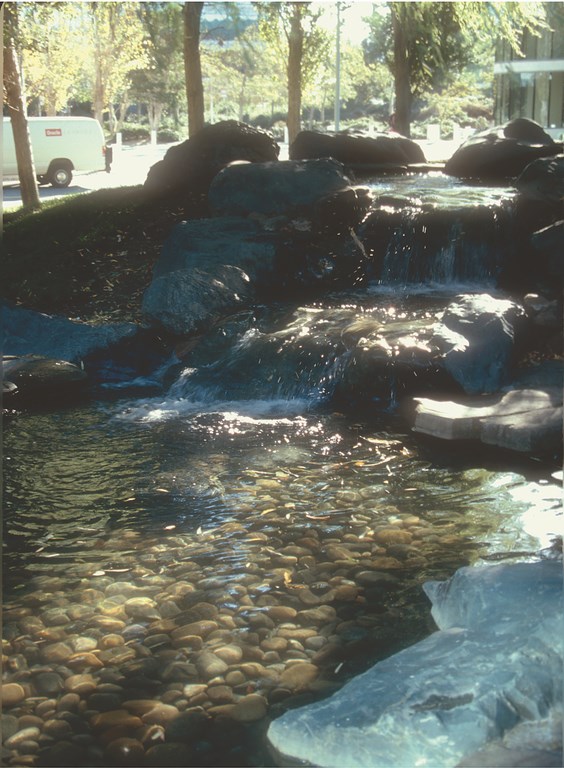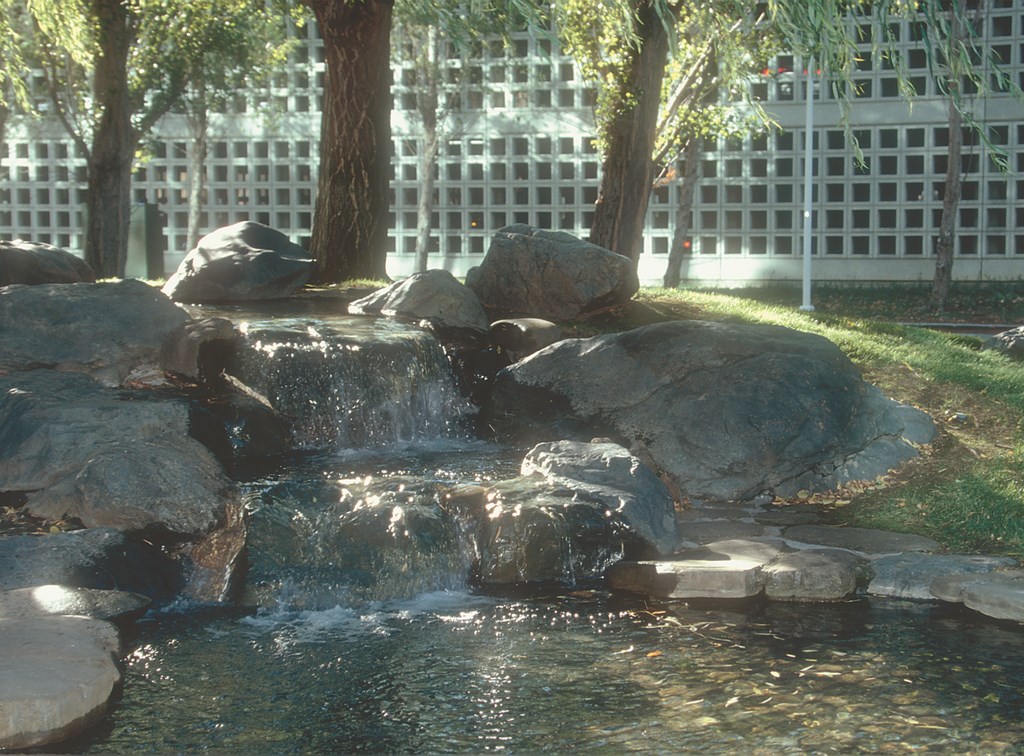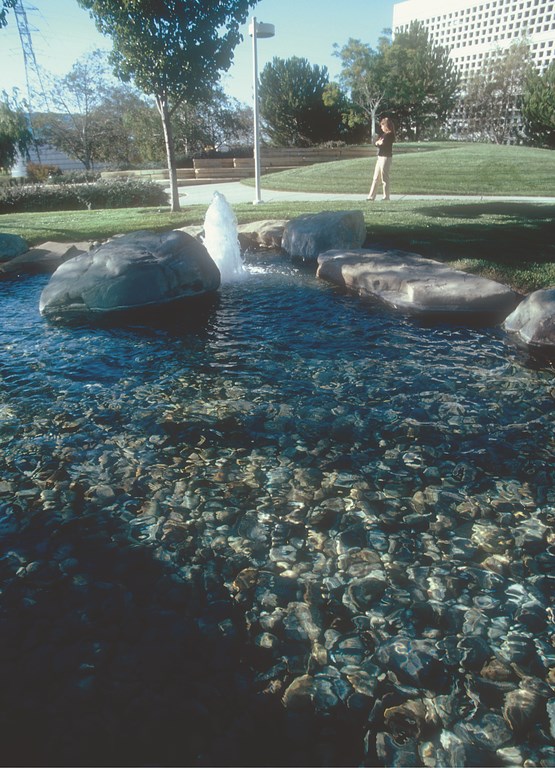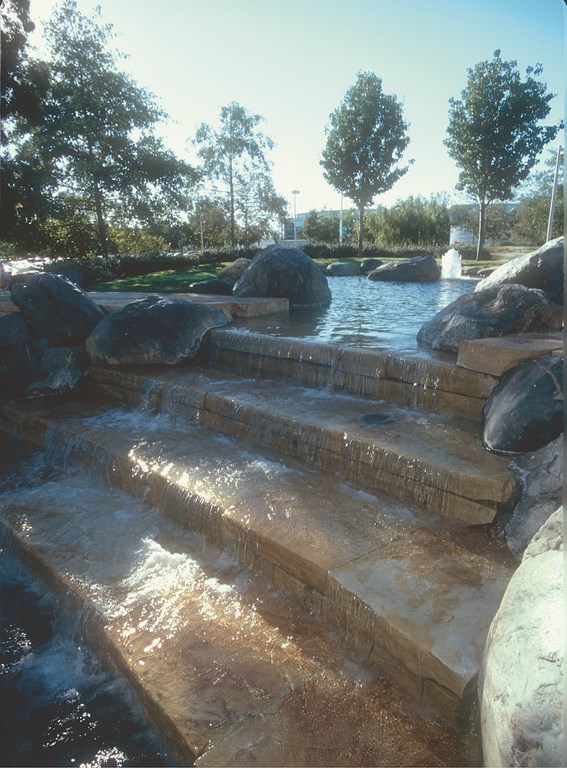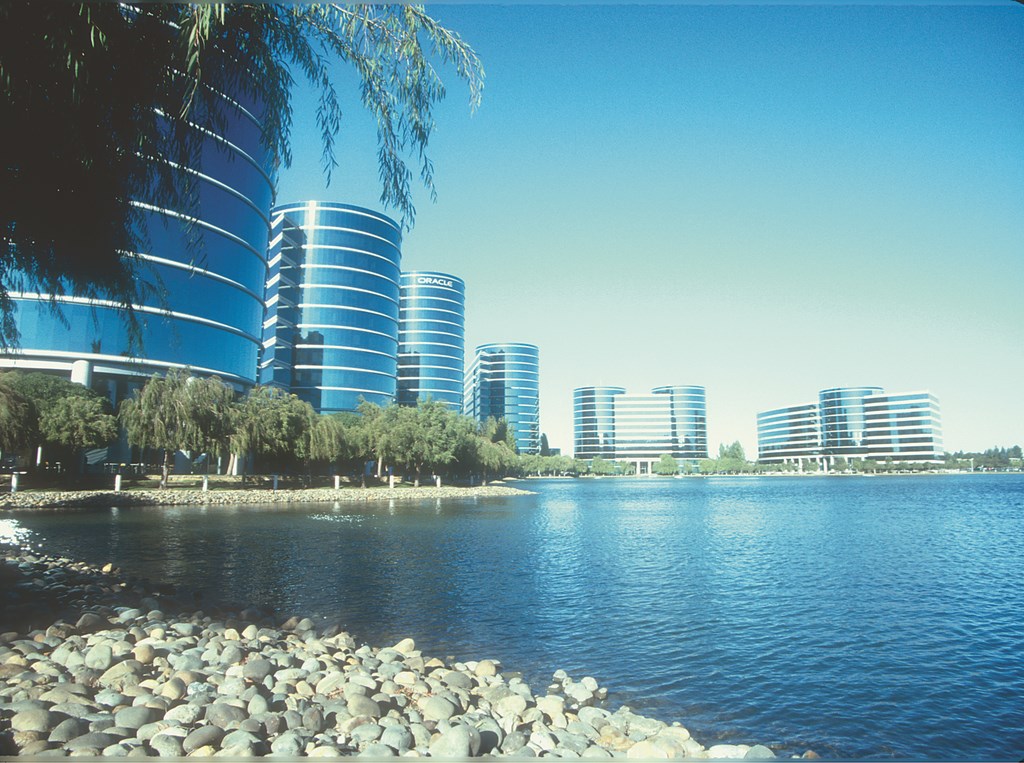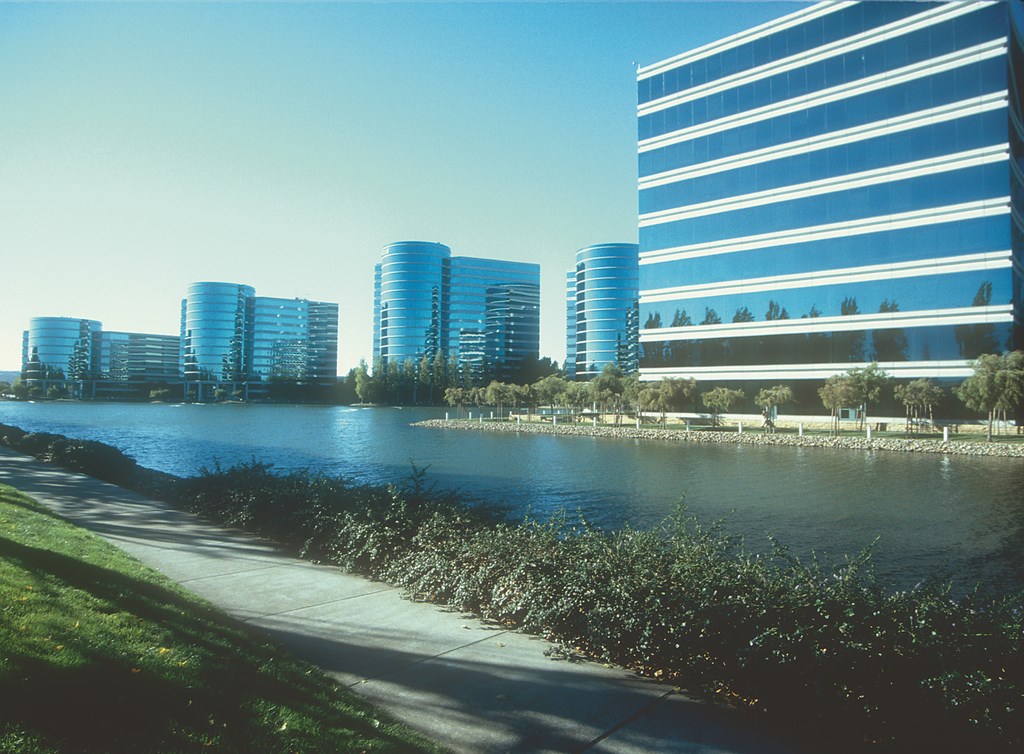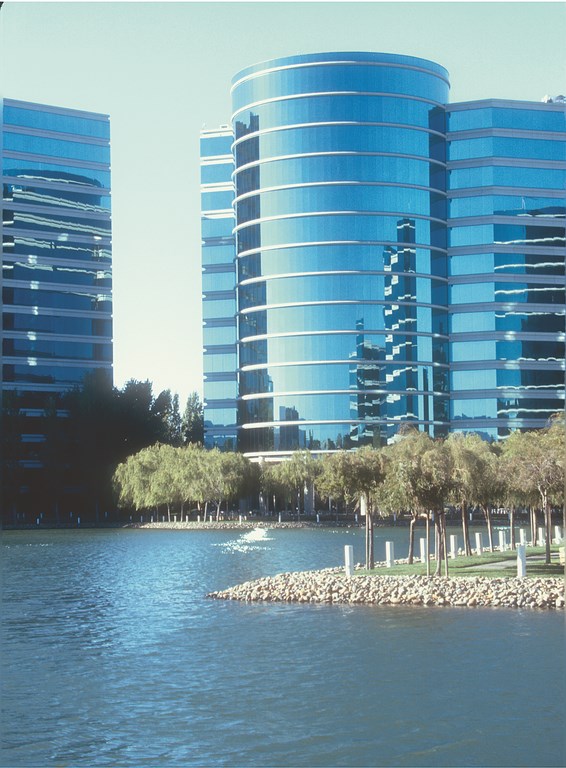Clearwater Credence
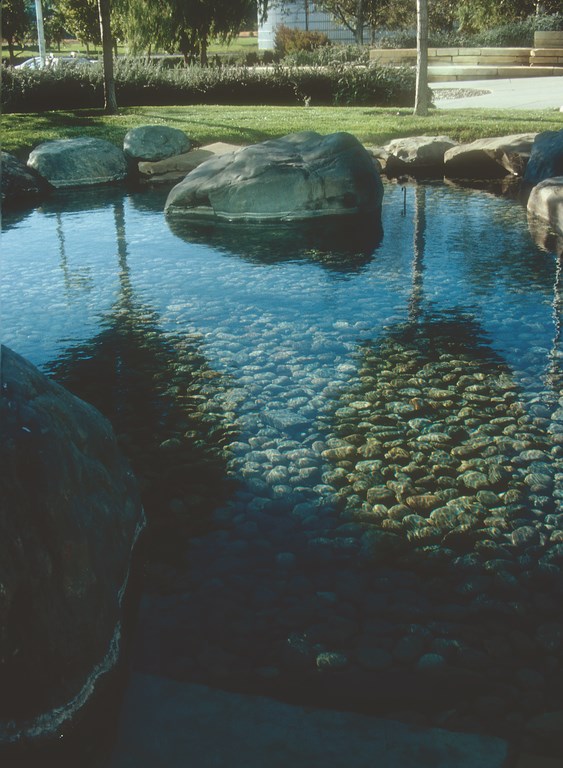
Even compared to other spectacular facilities established by Silicon Valley’s high-flying software industry, Oracle’s corporate campus is truly impressive.
The mirrored-glass architecture and warm, meticulously maintained grounds are only the start of the story. As you dig deeper, you find a range of employee-oriented amenities both inside and outside the buildings that make it tough to do anything but admire the audacity involved in creating such a workplace – and envy the people who work there.
The management at Oracle makes no bones about it: All of the opulence is designed to attract and retain employees capable of developing cutting-edge software systems. That’s why you’ll see designer furniture in the offices, international cuisine in the restaurants and beautiful artwork throughout the compound. It’s an amazing place, and one that has been scrupulously maintained since construction was completed in the early 1990s.
The watershapes reflect the management’s lofty sensibility and are an integral part of an overall scheme of plazas, rolling lawns, pathways and places to relax, meet or socialize with fellow workers. Our role since 1998 has been to maintain the five architectural waterfeatures and the five-acre, brackish-water lagoon and geyser that front the facility. In a change of pace, this isn’t a story of how the watershapes were built; rather, it’s about what it takes to keep these grand-scale systems working.
THROUGH THE GLASS
From the beginning, the staff at Oracle let us know that maintaining absolutely pristine water quality was our top priority, and they’ve invested significantly and consistently in the work needed to continue to upgrade and maintain the facility with that goal in mind.
Every year, we submit detailed proposals for anticipated work, including almost-daily service, major repairs, equipment replacement and a lake-management plan for the lagoon. The work that follows those discussions and negotiations is a huge undertaking that requires almost constant vigilance as well as a keen understanding of water-quality issues and what’s required to manage large watershape systems.
The campus was built in phases from the late 1980s to the early ’90s. It consists of five main buildings, and as each rose into the skyline, watershapes were installed to grace the grounds below. Today, there are three unusually large stream/fountain systems strategically located between the buildings, with two smaller fountains located near the main entrances of two of the buildings.
The first of the three large watershapes installed in the earliest days of the complex has a somewhat “dated” appearance and was driven by similarly dated equipment. It begins in a series of small pools surrounded by rocks and decking that feed a stream that flows over a series of poured-in-place concrete steps with a dark-green tint.
| Crystalline water clarity is our goal with every one of the watershapes on the Oracle campus – a prospect made challenging by the presence of lots of deciduous trees. |
The two newer watershapes are made of limestone block, both with highly sculptural appearances and perhaps the most striking and complex exterior features on the campus. On the larger of the two, the flow initiates in a large reflecting pool edged by sloping grass. Boulders sit around the edge, with several benches under trees – to my mind, the most restful area on the entire campus.
The pool feeds a stream that flows under a pedestrian bridge and then over a series of limestone weirs into a lower reflecting pool. It’s an interesting mix: a free-form body of water at the upper level, quite natural in appearance, with transitions to sculpted structures below.
There’s a second, somewhat smaller feature of similar design. Built at the same time as the large feature, it lacks the pond and stream and instead has water issuing from a split boulder in the center of a reflecting pool. In this case, colorful cobblestones are visible through the crystal-clear water.
There are also two small fountains made of concrete poured into a block-style form of structure. The concrete has a rough finish and a rugged appearance that contrasts with the crisp architecture all around them. The water wells up from the center of the block structures and pours over the sides to be collected in small reservoirs covered in smooth river cobble.
SERVICE ON HIGH
Our assignment is to keep all of these systems operating and up to date; the fountains clean of debris; and, most important of all, the water as clear and inviting as possible.
And the water is definitely inviting. In fact, there’s a great deal of human interaction with the fountains, including the occasional child or grown-up who walks right up to touch the water, and we’re mindful of the fact that the facilities are used all day, every day of the week, which means the waterfeatures are running the vast majority of the time.
It’s no mistake that all of the watershapes are located near restaurants and in plain view of staff and anyone else who happens to be on campus. From the start, we knew that top-notch water quality was not just a matter of aesthetics, but also conveyed messages about health and safety as well.
| The use of mechanical systems of aerators and pumps keep the water moving and prevent many clarity-related problems, but the fact is that these watershapes require near-daily care by service staff. |
The easiest systems to maintain are the block fountains, which feature simple re-circulating systems driven by single pumps. The only real work here is removing the leaves that tend to collect in the reservoirs: There are no filters to clean, so the regimen is a thorough twice-yearly drain and clean – with a near-daily picking up after the trees. In addition to these basic maintenance services, we will reset operational times and periodically inspect the mechanical systems to make sure the pumps are functioning properly.
The architectural fountains are more complex, and one of the first things we did was replace the original equipment. The dated pump’s strainer baskets were far too small for the application and the filters were less efficient than we wanted, so we replaced them with WhisperFlo pumps and Triton sand filters from Pentair Pool Products (Sanford, N.C.). It helped that we were familiar with the new equipment’s reliability and serviceability, but it also was important that the new pumps’ strainer baskets have much greater capacity and therefore require less-frequent attention during the fall season.
The volume of debris is indeed an increasing challenge: As the landscape has grown, more and more leaves accumulate in the watershapes to the point where enlarging skimming capacities and upsizing pump strainers has been a real priority. Just staying a step ahead of these deciduous beauties – mostly poplars and dogwoods – is a full-time job.
As they’ve matured, the trees put on shows in the spring and fall that have become truly spectacular, but they also make a real mess. So while altering and upgrading systems has been a necessity, we’ve also had to increase the hours spent cleaning and treating the water.
CLEAN CHEMISTRY
With the exception of the lagoon, all of the campus’ watershapes rely entirely on sand filters (rather than bio-filtration) to polish the water. The larger fountains and reflecting pools and streams are all chlorinated using a granular trichlor added by hand during service events.
Given the scale of the watershapes, we go to great lengths to monitor chlorine levels and keep the residual at a low level – not more than one or two parts per million – as a way to stave off any chlorine odors. We use trichlor because it dissolves quickly and is 90% available chlorine. Trichlor also has a longer-lasting residual, and well-balanced systems tend not to gas off as rapidly. This helps us maintain proper chlorine levels over a longer period, saving time and money and reducing the possibility of overchlorination.
| The aim of all of our work in maintaining systems and working with the water is to create an environment as relaxing and soothing as possible for the company’s employees – a task made easier by management’s commitment to our mission. |
We also watch pH closely to ensure that we aren’t damaging concrete or stone surfaces with corrosive water. Our target is the narrow range from pH 7.4 to 7.8 – just on the basic side of neutral. This promotes a bit of scale formation, but that’s something we can deal with easily when we maintain, drain, clean and refill the systems. (This is far simpler than dealing with the etching or pitting of grout and concrete structures that would occur in acidic water.)
As with any clear-water or swimming-pool-type system, filtration, cleaning and water chemistry require constant vigilance. With a high-use site such as this one, and especially given Oracle’s demand for impeccable water quality, it’s critical to do the work based on what the systems need day by day instead of just following a maintenance schedule. Truth is, we adjust our routines all the time. We also try to anticipate problems, particularly pump failure, and have established procedures with the client that let the work move forward quickly when equipment needs replacing. This minimizes down time – a critical issue for facility managers.
We do, however, have schedules for draining each of the features (with the exception again of the lagoon) twice each year to let us effect repairs, clean the filters and clear away accumulated debris. As a valuable side benefit, regular draining enables us to rid the systems of any water quality problems that might be starting to develop as a result of nutrient loading or other storm-related events.
That last point is important, because the semi-annual draining and refilling lets us reduce use of chemicals frowned upon by the regulators who enforce rules governing discharge into storm drains. It also lets us remove whatever tree-related gunk has accumulated on the cobbled bottoms of the features – a key step in our program of keeping the view through the pristine water as pleasing as possible.
As mentioned above, we’ve also spent time on reconfiguring plumbing systems to increase skimming action in the ponds. In the case of the oldest fountain/stream system, this meant removing a good deal of decking and replacing the liner, which had begun to leak. We also chased down a number of problems having to do with cracks in concrete and leaking sections of plumbing.
LAKEFRONT PROPERTY
For all the prominence and aesthetic importance of the watershapes directly adjacent to the buildings of the Oracle complex, there’s no doubt that the lagoon, mentioned in passing several times so far, is the most noteworthy of all the features on the campus.
It’s what people see as they arrive on the site, and the fact that it offers shimmering reflections of the company’s office towers is particularly impressive and eye-catching. Covering about five acres, the lagoon is approximately six feet deep throughout and is fed by sloughs that run from the south end of the San Francisco Bay, making the lagoon both brackish and, to a degree, tidal.
The lagoon is maintained with no chemicals or filtration of any kind. Instead, we use the tides and rely on a carefully controlled exchange of fresh bay water with brackish lagoon water to ensure a clear feature that is free of intrusive plant growth, algae or stagnancy.
| The most prominent of all the watershapes on the Oracle campus is the lagoon, a tidal basin fed by the waters of San Francisco Bay. No chemicals or filters are used: It’s our responsibility to manage the flows in and out to ensure pristine water at all times with no invasive plant growth, algae blooms or stagnancy. |
The lagoon pre-dates the Oracle campus and was part of the Marine World complex, one of the first marine parks. Although this system is a far cry in terms of functionality and controllability from the watershapes of the interior areas of the campus, Oracle’s management let us know in no uncertain terms that water quality was just as important in the lagoon as it was everywhere else – and perhaps more so.
The water’s flow in and out of the lagoon is controlled by two large vaults and a massive pump. The vaults are there to regulate water level and avoid extreme tidal fluctuations in the lagoon. (Left on its own, the water level would swing by as much as five or six feet within a given twelve-hour period. With the vaults, we’re able to keep the water level stabilized within a six-to-eight-inch range.)
One vault is dedicated to outflow and allows water to escape during low tides. The second controls the inflow and lets water enter the lagoon during high tides at a regulated pace through an adjustable sluice gate. The discharge-pump system forces water out via an 18-inch line that connects the lake to a bay slough and serves for both stormwater control and water exchange.
The water exchange is enhanced by the large pump, which operates between 10 and 12 hours each day. We use a mathematic algorithm that takes into account the water coming in and out via the tides as well as the additional water we need to remove via the pump in order to maintain water quality and/or reduce any risk of flooding.
SEASONAL VARIATIONS
The time settings on the lagoon’s various pumps and gates vary according to season and attendant shift in tidal levels. These are big numbers in all cases, and we put them to work in meeting our rough goal of replacing at least 10% of the lagoon’s water each day.
To get the job done, a 50-horsepower pump on an 18-inch discharge line moves 500 gallons per minute via a submerged suction assembly. The vaults are quite large: The outflow vault is 20 feet long, 12 feet wide and 12 feet deep, while the influent vault is about half that size. They’re difficult to access because they’re covered with immense grates – removal of which is a big job all by itself that calls for a truck-mounted crane. All maintenance and cleaning operations are performed in chest waders. For the most part, repairs are done by scuba divers.
These are big systems that have worked beautifully for many years now, but we constantly monitor their operating condition and change the settings on the valves and sluice gates according to tidal charts. It all requires a good deal of monitoring and a lot of calculating to keep inflows, outflows and water exchanges at acceptable rates, and the results are clear: The water is completely free of the intrusive plant life that tends to invade similar bodies of brackish water nearby.
One of the keys to maintaining the lagoon’s water quality is the aeration provided by the five-story geyser located at its center. The original feature, which was the most difficult of all to maintain, consisted of a 50-hp pump located in a submerged vault that fed a perforated eight-inch nozzle mounted on a standpipe in the lake’s center. This system was troubled by a number of problems, the most significant having to do with water intrusion – not a good thing with equipment running on 480-volt power service. In addition, the impellers degraded rapidly and were very expensive to replace.
Happily, we’ve replaced that system with a self-contained, floating-fountain system made by Aqua Control, Inc. (Peru, Ill.). The support staff there helped us design a system that will provide the exact same appearance on the water as the original geyser, but one that frees us of the need to work with high voltages in a leaky sub-grade vault. The new unit also has lighting to accent the feature at night.
As emphasized at several key points, maintaining watershapes such as these can never be strictly a matter of routine. Not only is it about making seasonal adjustments or, in the case of the lagoon, tidal calculations and doing what it takes to meet a client’s needs, but it’s also about not settling for the status quo and striving constantly to find effective ways of improving water quality.
It takes a lot of dedication to do things in this way. But given a client like Oracle and its manifest dedication to creating a setting in which staff is constantly inspired and soothed by the presence of water on a grand scale, is there any possibility of delivering anything less than true excellence?
George Forni is president of Aquatic Environments, an Alamo, Calif.-based design, installation and service firm specializing in lakes, ponds and other large waterfeatures. He started his career in the waste- and reclaimed-water industry in the mid 1980s. Before long, he became project manager for an aquatic service firm, for which he managed a number of projects in conjunction with the U.S. Army Corps of Engineers as well as in other regulatory agency-controlled jobs. His company now focuses mostly on the needs of large commercial clients in the Western United States.











